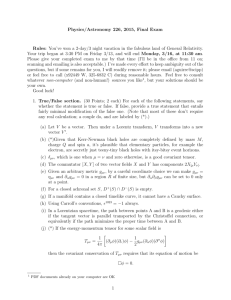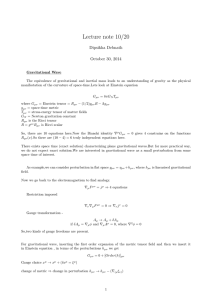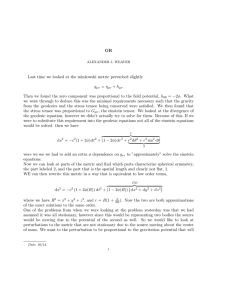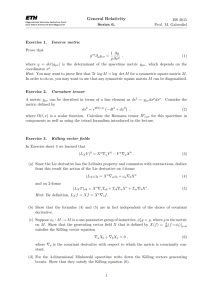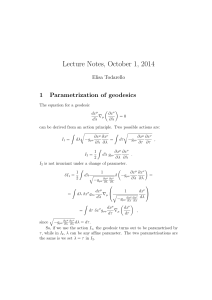Quantum Instabilities of deSitter Spacetime National Tsing Hua Larry Ford University
advertisement
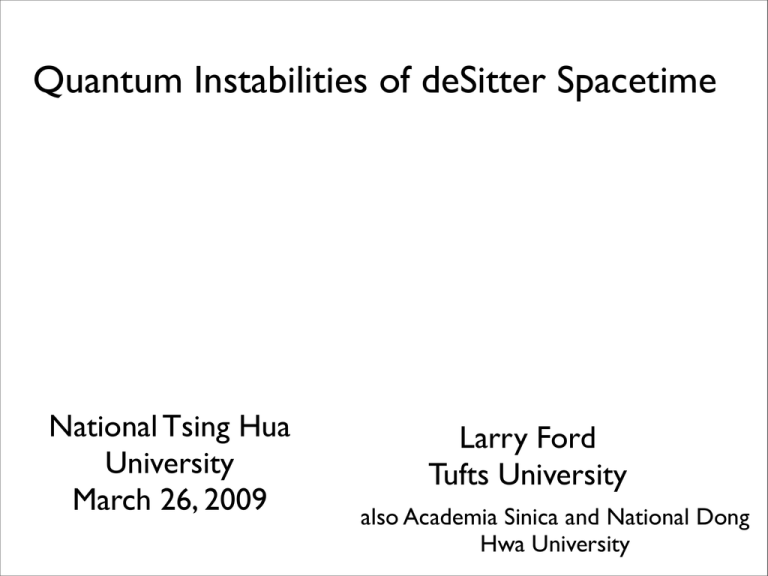
Quantum Instabilities of deSitter Spacetime National Tsing Hua University March 26, 2009 Larry Ford Tufts University also Academia Sinica and National Dong Hwa University deSitter Spacetime Solution of Einstein’s equations with a positive cosmological constant Global deSitter spacetime is maximally symmetric 10 Killing vectors in 4 dimensions, Same as Minkowski spacetime A portion of deSitter spacetime describes inflationary expansion ds = −dt + a(t) (dx + dy + dz ) 2 2 2 a(t) = e Ht 2 2 2 Why is the stability of deSitter space important? Instabilities might alter the predictions of inflationary models. Instabilities might lead to a natural resolution of the cosmological constant problem. decaying cosmological constant models e.g., Dolgov, Barr, LF, ect Part I: Gravitons in deSitter Spacetime quantize linear perturbations active fluctuations of geometry Write gµν = γµν + hµν background (deSitter) metric metric perturbation tensor modes Impose the transverse tracefree (TT) gauge: h µν ;ν =0 h= covariant derivative on the background µ hµ =0 hµν u = 0 µ a timelike vector; here the comoving obverver 4-velocity Result: tensor modes behave as massless scalars Lifshitz 1946 µ !S hν =0 scalar wave operator Consequences: deSitter space is classically stable gravitons are equivalent to a pair of massless scalar fields !S ϕ = ϕ ;ν ;ν =0 Infrared divergences !ϕ(x)ϕ(y)" is not defined in the deSitter invariant state (Bunch-Davies) vacuum, but can be defined in a class of states which break deSitter symmetry Linde, Starobinsky, Vilenkin & LF Consequence: linear growth in comoving time 3 H t !ϕ " ∼ 2 4π 2 3 H t !h hµν " ∼ 2π 2 µν Is this growth an instability of deSitter space? One loop level: No, gauge invariant quantities do not grow LF 1985 Two loop level: Controversial Tsamis & Woodard (1996) claim to find cosmological constant damping Λef f = Λ(1 − −2 4 π "p H t ) 6 2 Λ =3 H 2 Planck length This result disputed by others (Garriga & Tanaka) An alternative model: gravitons coupled to photons J.T. Hsiang, D.S. Lee, H.L. Yu & LF Preliminaries: stress tensor renormalization in curved spacetime regulator Divergent parts: Einstein tensor parameter " gµν Gµν ! (1) (2) !Tµν " ∼ A 2 + B + C1 Hµν + C2 Hµν ln σ σ σ (1) Hµν " δ !√ 1 1 2 ρ 2 ≡√ −gR = 2∇ ∇ R − 2g ∇ ∇ R − g R + 2RRµν ν µ µν ρ µν µν −g δg 2 scalar curvature (2) Hµν " δ !√ 1 1 1 αβ α ρ ρ αβ ρ ≡√ −gR R = 2∇ ∇ R − ∇ ∇ R − g ∇ ∇ R − g R R + 2R αβ α ν ρ µν µν ρ µν αβ µ µ Rρν µν −g δg 2 2 Ricci tensor Add R in the gravitational action and write Einstein’s equations as 2 αβ R R and αβ counterterms Gµν + Λ0 gµν + (1) α0 Hµν + (2) β0 Hµν = 8πG0 !Tµν " Remove the divergent parts of !Tµν " by a renormalization of G0 , Λ0 , α0 , β0 We want the renormalized values of α0 , β0 = 0 to avoid a fourth order equation. In general, !Tµν "ren is not expressible in terms of geometric quantities. An exception: conformally invariant fields (e.g., photons) in a conformally flat spacetime (e.g. deSitter space). (in the vacuum state) Here where Bµν Bunch, Davies, Brown & Cassidy 1 2 1 2 αβ ρ = Rαβ R gµν + RRµν − Rµ Rρν − R gµν 2 3 4 31 C= 1440π 2 µ Bµ !Tµν "ren = C Bµν != 0 (photons) conformal anomaly In deSitter space, !Tµν "ren ∝ gµν so just shifts Λ Our model: assume that this form for !Tµν "ren holds in perturbed deSitter spacetime. Self consistent: Bµν is still a conserved tensor. Key result: equation for the metric perturbations becomes µ !S hν + 48π C 2 "p H 4 µ hν =0 tachyonic mass and has an exponentially growing solution: µ hν ∝e 16πC 2 #p 3 H t Gauge invariant quantities, such as the Ricci tensor, also grow. Time scale for the onset of the instability is 1 τ= ≈ 16πC #2p H 3 Ep = Planck energy 2 E 4 p 10 2 EI H −1 EI = energy scale of inflation Implications: Allows adequate inflation to solve horizon & flatness problems Does not allow for eternal inflation. Part II: Quantum Stress Tensor Fluctuations in deSitter Spacetime C.H. Wu, K.W. Ng & LF; also work in progress with S.P. Miao & R. Woodard Basic idea look at the effects of fluctuations of the vacuum electromagnetic field stress tensor. Stress tensor and expansion fluctuations α u = 4-velocity of a congruence of timelike geodesics θ= α u;α = expansion of the congruence Raychaudhuri equation Rµν = 8π(Tµν 1 − gµν T ) 2 Ordinary matter: focussing Tµν Fluctuations θ Fluctuations Conservation law for a perfect fluid: ρ̇ + θ(ρ + p) = 0 E.g., Robertson-Walker universe: Stress tensor fluctuations imply density fluctuations (Not necessarily for the same field) Robertson-Walker Spacetime dt = a(η)dη dt = comoving time dη = conformal time Conformally invariant fields: RW Cµναβ (x, x! ) =a −4 (η) a −4 (η ! f lat ) Cµναβ (x, x! ) Stress tensor correlation function Cµναβ (x, x! ) = !Tµν (x) Tαβ (x! )" − !Tµν (x)"!Tαβ (x! )" (conformal anomaly cancels) θ fluctuations Assume σµν = ωµν = 0, so that dθ 1 2 µ ν = −Rµν u u − θ dλ 3 Let θ = θ0 + θ1 , where θ0 = 3ȧ/a, and dθ1 2 µ ν = − (Rµν u u )q − θ0 θ1 dt 3 θ1 (t) = −a −2 (t) ! t t0 dt a (t ) (Rµν u u )q " 2 " µ ν Expansion correlation function: !θ(η1 ) θ(η2 )" − !θ(η1 )"!θ(η2 )" = (8π)2 × ! η1 ! η2 −2 −2 −1 " −1 " a (η1 ) a (η2 ) dη a (η) dη a (η ) E(∆η, r) η0 η0 E(∆η, r) = flat space energy density correlation function (r + 3∆η ) = 4π 4 (r2 − ∆η 2 )6 2 Eem 2 2 Treat as distributions - integrate by parts Inflationary expansion followed by reheating and a radiation dominated universe 1 a(η) = , 1 − Hη η0 < η < 0, a(η) = 1 + H η, η0 = conformal time when inflation begins η > 0, tR = reheating time in comoving time a(t) = e H(t−tR ) , t ≤ tR , ! a(t) = 1 + 2H(t − tR ), t ≥ tR . Effect of expansion fluctuations on redshifting after reheating Let p = wρ and integrate the conservation law to find the density fluctuations: !" δρ ρ #2 $ = (1 + w)2 % ηs dη1 a(η1 ) % ηs dη2 a(η2 ) 0 0 (!θ(η1 ) θ(η2 )" − !θ(η1 )"!θ(η2 )") ηs = conformal time of last scattering Power spectrum of the density fluctuations: !" δρ ρ #2 $ = % 3 i! k·∆! x d ke (Non-Gaussian fluctuations) Pk (ηs ) ! Result: Pk = 4 −!p (1 4 3 k |η0 | 2 + w) ln [a(η )] s 480π 2 2 ! 3 Pk ∝ |η0 | Grow as the duration of inflation increases- a different instability of deSitter space. Interpret as due to non-cancellation of anti-correlated θ fluctuations. Interpret the sign as telling us whether the density fluctuations on a given scale are correlated or anti-correlated. density perturbation: a quantum gravity effect ! "3/2 δρ S 2 ∝ #p ρ λ S = H|η0 | = expansion factor during inflation λ= length scale of the perturbation Constraint on the duration of inflation: ! 12 "5/3 δρ 10 GeV −4 37 S < 10 < 10 ER ρ reheating energy Allows enough inflation to solve the horizon and flatness problems Opens the possibility of observing quantum gravity effects as a non-Gaussian, non-scale invariant component in the large scale structure. Summary 1) deSitter space is classically stable. 2) In pure quantum gravity, it is stable at the one loop level. 3) This may not hold in higher orders? 4) In a simple model with gravitons + photons, there is a homogeneous instablity. No eternal inflation. 5) When stress tensor fluctuations are included, there is also an inhomogeneous instability. 6) The latter could produce observable features in large scale structure.
